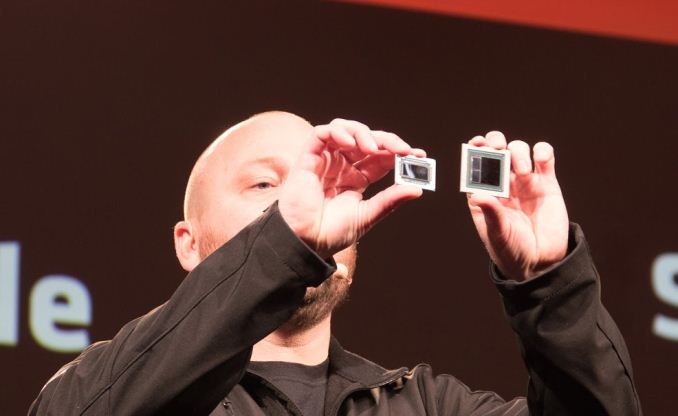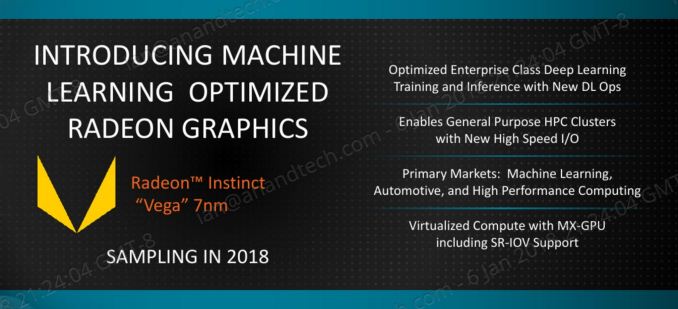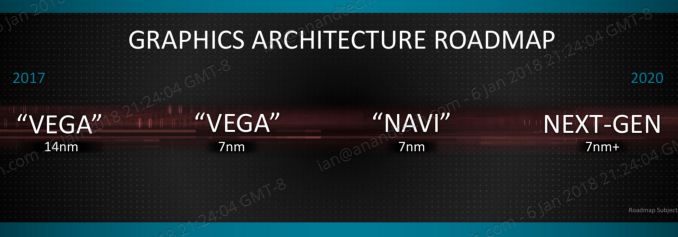AMD Tech Day at CES: 2018 Roadmap Revealed, with Ryzen APUs, Zen+ on 12nm, Vega on 7nm
by Ian Cutress on February 1, 2018 8:45 AM ESTVega in 2018
One of the more disappointing elements to the roadmap announcements at AMD’s Tech Day was about graphics, and specifically Vega. To put it bluntly, there are no updates from AMD coming to the consumer desktop graphics market in 2018. With everything going on regarding the cycle of GPU architectures, and the insatiable demand for AMD graphics cards from cryptocurrency miners driving prices sky-high, the enthusiast and high-end gamers are getting the thin-end of the wedge.
Unfortunately, AMD is getting the blame for this, with many gamers blindly demanding ‘why not make more?’. In a recent earnings call, AMD CEO Lisa Su that they are making as many Vega graphics processors as possible, and also increasing their order with the fabs to produce more. Dr. Su put the problems with production squarely in the hands of the DRAM manufacturers, stating that memory supplies (GDDR5 and HBM2) are not sufficient to meet the high demand from everyone that needs them, which is also driving up cost. As a result, AMD isn’t blaming itself for the lack of GPUs being made available to consumers, but is saying that Samsung, Micron, and SK Hynix are not producing enough. AMD seem to be selling as many GPUs as they can make, which is good for their balance sheet at least.
So while there is nothing to look forward to on the desktop graphics side, AMD did mark on its roadmap two specific graphics products for 2018.
Vega Mobile, with HBM2
The graphics strategy in notebooks is bifurcated for AMD. On one side, their Mobile APU business takes care of the low-end of the market. The recent business relationship with Intel to sell graphics chips for Intel’s high-end mobile processors means AMD has a business on that side. The big hole in the middle is for notebook customers that want discrete graphics. After a couple of years of large Polaris based designs using GDDR, AMD is bringing Vega to this market.
As far as AMD were prepared to announce, a single Vega Mobile design is being prepared, which might be subject to binning based on compute units. The full amount of compute units in the chip has not been made publicly available, however it measures basically half of the full Vega 64 chip next to it. This would normally suggest a 32 CU chip, however there are a number of front-end elements required which have a fixed size – compared to the Intel 24 CU chip for the Intel with Radeon Graphics processor, this chip seems to be of similar size, if not bigger.
What we do know about the Vega Mobile processor is that it is paired with 4GB of HBM2, using an embedded interposer to give an overall z-height of 1.7mm. This is AMD’s second or third generation of interposer technology, and it has come a long way since Fiji: the interposer is tight along the dimensions of the GPU and HBM, but it is also embedded into the PCB. The embedding allows it to reduce the height, making it a better fit for ‘thin and light’ mobile platforms. The interesting correlation here is that at 1.7mm, it matches Intel’s EMIB implementation which is also 1.7mm. This caused two theories: either AMD is using EMIB (it isn’t), or it means that the perceived z-height benefit from using EMIB might not exist. The latter is true: AMD has unequivocally confirmed that it is using an interposer, and does not have access to Intel’s EMIB.
Ultimately AMD created more questions and answers with this announcement. Nothing was said regarding power, price, expected CPU/GPU combinations, or which notebook partners they have ready to use it. The only element to the discussion was that the chip will enable VR-capable notebooks, support HDMI 2.1 variable refresh rates, and will be coming in 2018. (Not to be all Maudlin, but watch out for the GPU manufacturer that puts three on a graphics card and sells it to miners.)
AMD Sampling 7nm Vega in Q4 2018
In previous roadmaps, AMD stated that it would be using a 14+/12nm process node for an update to its Vega design. At the Tech Day, that part of the roadmap no longer existed, and in its place was the announcement of a 7nm Vega graphics processor to be sampled at the end of the year.
This announcement came with a lot of questions, specifically whether 7nm would be ready for Q4 2018. AMD clarified its remarks by saying that this product will not be aimed at gamers, but will be a version of Vega specifically for machine learning, and they expect only to be sampling select customers with early silicon at the time.
This slide above lays most of it out: the design will be an optimized version of Vega, which means it might not look much like a Vega GPU as we know it. AMD is planning that this product is used both for training and inference, with a focus on new deep learning operations – specifically aimed at HPC clusters. AMD also cites a new high-speed IO in play, which might be a version of Infinity Fabric designed to compete with NVLink, as well as virtualization support.
With 7nm in its infancy, we highly expect it to be a small bit of silicon, something akin to the current Radeon Instinct MI8. By using small silicon in a high margin market, this will allow AMD to optimize the design plans for its other 7nm products. This is what Ryan called a ‘pipe-cleaner’ processor, and it makes sense for semiconductor fabs to focus on smaller processors to start with, as these will yield at higher rates.
With a planned sampling in Q4 2018, we might expect volume production to be nearer Q2 2019. This means that the next generation of consumer-focused graphics, perhaps using the newer Navi architecture, will be in the mid-2019 timeframe. According to AMD’s roadmaps, it is committed to demonstrating Vega on 7nm, Navi on 7nm, and a ‘next-gen’ design on 7+ before the end of 2020. Obviously there was no clarification on whether that final design is consumer or enterprise focused for 2020. In our recent interview with AMD’s CEO, when asked if the GPU market will at some point have to bifurcate between gaming focused and compute focused designs, Dr. Lisa Su stated that ‘it must be the case’.
Updates on AMD and RTG
At the time of the event, AMD was in technical limbo, with former Radeon Technology Group leader Raja Koduri leaving for Intel. Since the event (i.e. between the event and the time this is published), AMD has reimagined the role and hired two people to fill it: Mike Rayfield will head up the business side of RTG, while David Yang, who used to work for AMD on GPUs, is rehired to take control of the technology side of RTG.
You can read our analysis of these hirings here.













131 Comments
View All Comments
A5 - Monday, January 8, 2018 - link
Anything that is forbes.com/sites/* is not credible. You can literally go sign up for one right now if you want.And Forbes proper isn't credible on anything outside the financial industry.
iwod - Monday, January 8, 2018 - link
I mean Christ, you have financial industry reporter reporting on tech they barely understand and having reader that credit a non technical Journal pieces as creditable source and then attacking a journalist on a technical information site labelling him or her and the site as not creditable and when the journalist has a bloody Oxford PhD in the ElecChem Field.LurkingSince97 - Thursday, January 18, 2018 - link
LOL.GloFo announced LONG AGO that they were skipping the 10nm node and going straight from 14nm to 7nm. They mentioned that there would be some 14nm tweaks.
Other competitors started tweaking their 14nm / 16nm nodes and in some cases re-branded them (tsmc, IIRC rebranded a 16nm improvement as 12nm).
There is more than one feature size measurement in a process, being able to shrink a small subset of these by a little bit will allow for some increased density. Add on some other tweaks and you can lower power too. What do you call a heavily tweaked node that only shrinks a few of the feature sizes but not all? What number is half way between 14 and 10?
It doesn't really matter what they call it. Its ~ 10% faster or 10% lower power, with ~10% to 15% higher density.
The 12nm process is essentially a 14nm+, or ++. Its not a wholly new node. Fact 1: it will be incrementally deployed as a revision to the 14nm process where you start over nearly from scratch and almost the entire manufacturing pipeline is new. Fact 2: Unlike most minor tweaks, it does increase density. There is some justification in giving it a new size due to fact 2, but it is not a brand new process due to fact 1.
A truly new node takes _years_ to develop, not months. This appeared on their roadmap suddenly. Everyone and their brother (other than you) knew that they had a 14nm+ in the works -- AMD's roadmaps had "Zen+" on a GloFo "14nm+" node. Suddenly there was no more "14nm+" on AMD's roadmaps, and it was replaced with "12nm".
Significant tweaks to an existing node however,
LurkingSince97 - Thursday, January 18, 2018 - link
Ugh, I should proof-read:Fact 1: it will be incrementally deployed as a revision to the 14nm process where you start over nearly from scratch and almost the entire manufacturing pipeline is new.
Should say:
Fact 1: it will be incrementally deployed as an upgrade to the 14nm process (many of the manufacturing steps remain identical), while an entirely new node typically implies replacing almost the entire manufacturing pipeline.
Sane Indian - Monday, January 8, 2018 - link
"Acer will use the pre-announced higher-end APUs, the Ryzen 7 2700U and Ryzen 5 2500U, but will also be pairing this with a Radeon RX 560 graphics chip."Does iGPU and dGPU can crossfire or they just independently (switch from iGPU to dGPU and vice versa) depending upon power situation.
Ian Cutress - Monday, January 8, 2018 - link
Literally the rest of the paragraph answers the question.We were told by AMD that the integrated graphics and discrete graphics will be used in a switching context: for video playback, the lower power integrated graphics is used and the discrete is disabled, however the discrete graphics is fired up for gaming work. For compute, or for games that support multi-adaptor DirectX 12 technologies, both the integrated graphics and the discrete graphics should be available, however this is up to the game/software to implement.
Kevin G - Monday, January 8, 2018 - link
AMD executing right now and while there is argument that they've played it safe with Zen so far, they are in a very favorable position in the market. -"While most of the roadmap could have been predicted by those of us embedded in this industry, it was good to see AMD volunteering a lot of information. This can be a bit of a double-edged sword, if a competitor knows what you have planned". AMD knows that Intel's roadmap is in chaos as right now and pushing existing Zen designs to lower power envelopes and/or increasing clock speeds will close the performance gap. If Zen 2 advances in terms of IPC by any significant margin, they could actually pull ahead in 2019 but that entirely depends on Intel's response, in particular Ice Lake.Intel's missteps with 10 nm has left them open as the first Cannon Lake parts were due in late 2016! Meltdown and Spectre meltdown could have been the death blow to Cannon Lake as the incoming lawsuits make it unwise to release products with such significant flaws. Intel's server line up is also in chaos due to Meltdown/Spectre as Cascade Lake was pinned in as a stop-gap 14 nm solution before Cannon Lake-SP in 2019. Cascade lake for release this year should already be sampling but Meltdown/Spectre could force a delay. In particular is that Cascade Lake is supposed to support Optane DIMMs. The 10 nm Knight's Hill HPC processor has been cancelled roughly a month ago and replaced by Knight's Mill as a stop-gap for partners looking into AI. We'll probably find out later today when Intel's CEO takes the stage at CES.
wumpus - Monday, January 8, 2018 - link
"Death blow"? You seem to vastly overestimate the amount of silicon GoFlo can produce. Even if everything goes right for AMD, Intel will be shipping Cannon Lake chips left and right to consumers (the chips in the article appeared mostly for consumers) as GoFlo furiously produces Zepplin (or whatever its followup is called) and AMD ships them as hyperprofitable EPYC chips.That said, Intel certainly takes AMD competition seriously enough to throw together competing products such as the X299, even if such products make the rest of Intel look like they have no idea what they are doing. But still, massive gains for AMD will look like a tiny blip in Intel's revenue.
Orenj - Monday, January 8, 2018 - link
With Zen 2 already complete, I'm wondering if it contains any hardware assists for mitigation of Spectre-type attacks a la Intel's proposed IBRS/STIBP/IBPB?PixyMisa - Monday, January 8, 2018 - link
Unlikely; they've only known about this for a couple of months.